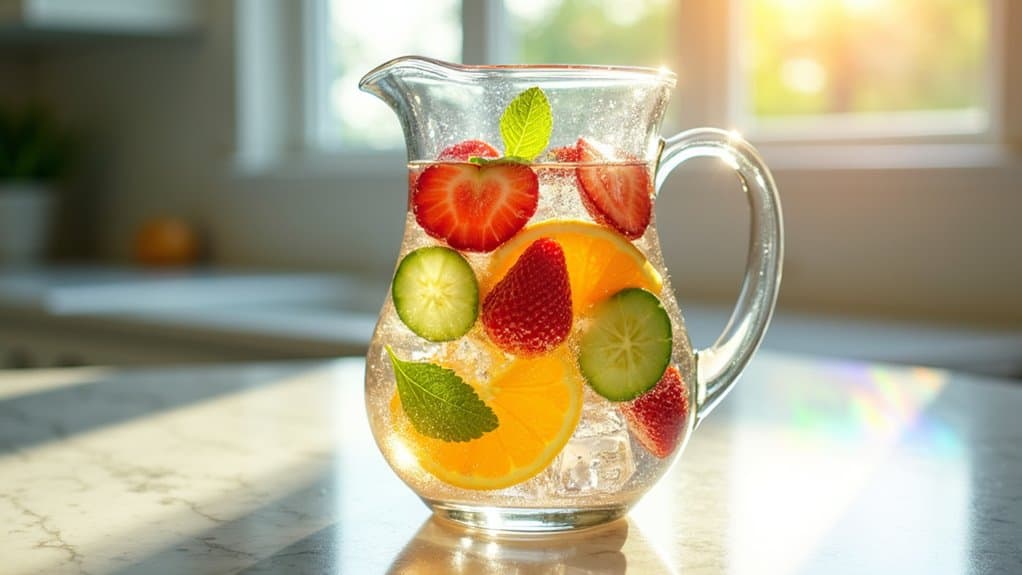Keep your child properly hydrated by making water their primary beverage, serving 2-2.5 cups of milk daily at mealtimes. You’ll want to offer water throughout the day, especially during active play, and create fun ways to track intake using sticker charts or fruit-infused options. For children under two, stick to whole milk, then switch to low-fat varieties. Limit juice to 4-8 ounces daily, and avoid sugary drinks completely. Understanding the right drink balance can transform your child’s health and development.
The Power of Plain Water in Child Development

While many parents focus on vitamins and nutrients, plain water plays an essential role in children’s cognitive and physical development. Your child’s brain requires balanced hydration patterns to maintain attention, memory, and ideal brain oxygenation throughout the day. Since early childhood exposure is critical for development, ensuring clean water access should be a top priority.
When your child stays properly hydrated, they’ll experience better task-switching abilities and enhanced coordination during physical activities. Even mild dehydration can impair their performance, trigger irritability, and cause headaches that affect their emotional well-being. Maintaining adequate water intake helps regulate body temperature effectively during outdoor activities.
You’ll want to encourage consistent water intake before they feel thirsty, as this proactive approach prevents fatigue and supports proper digestion. Research shows that children need higher water requirements compared to adults relative to their body mass. Watch for signs of dehydration like dark urine or dry mouth, and make clean, safe drinking water readily available during all activities to protect their developing minds and bodies.
Essential Guidelines for Milk Consumption
Although milk remains a cornerstone of children’s nutrition, following age-appropriate guidelines guarantees your child receives maximum benefits without potential drawbacks. When choosing milk, consider your child’s age and daily calcium intake requirements to confirm ideal growth and development. Children ages 12-24 months should consume 2-3 cups daily for optimal nutrition. Unflavored and unsweetened milk is the healthiest choice for children. Children between ages 1-3 should consume approximately 900-1000 calories from all food sources per day.
- Children under 2 need whole milk’s higher milk fat quality for brain development and general growth
- Switch to low-fat options after age 2 to maintain healthy weight while securing essential nutrients
- Monitor portions carefully too much milk can interfere with iron absorption
- Consider fortified alternatives if your child has allergies or intolerances
Remember to serve milk in open cups to prevent overconsumption, and always pair it with water throughout the day. If you’re using plant-based alternatives, choose fortified versions that match cow’s milk’s nutritional profile, especially for calcium and vitamin D content.
Smart Ways to Make Water More Appealing

Making water enticing for children can transform a basic health necessity into an engaging daily adventure. You’ll find success by offering infused water varieties using natural ingredients like citrus slices, berries, or mint leaves. Create visual appeal with fruit-filled ice cubes or layered fruits in transparent bottles.
Keep your children interested by introducing textured hydration options through frozen fruit purees or sparkling water alternatives. Since children ages 5-8 need 40 fluid ounces daily, establishing consistent drinking habits is essential. Set up fun tracking charts with stickers and turn drinking water into an exciting game with themed cups and group challenges. Since tap water is safe and budget-friendly, it’s an ideal choice for everyday hydration needs. You can strengthen these habits by modeling regular water consumption and establishing consistent water breaks throughout the day. For children under age 2, avoid sugary beverages completely to protect their developing health. Place water bottles in easily accessible spots and gradually replace sugary drinks to help your children develop lasting healthy hydration habits.
Understanding Age-Appropriate Drink Portions
Your child’s daily drink portions will alter noticeably as they develop, with water needs escalating from 4-8 ounces in infancy to several cups during the teenage years. You’ll want to balance your child’s fluid intake between water as the primary beverage and up to 2-2.5 cups of milk daily, depending on their phase of life. Children who receive plain milk and water early on tend to maintain these healthy drinking habits throughout childhood. To measure drinks precisely, use standard measuring cups or marked containers, and keep in mind that juice should be strictly limited – no more than 4-8 ounces daily for school-age children, with even lower amounts for toddlers. For children under two years old, it’s crucial to avoid sugar-sweetened beverages completely to promote healthy development.
Daily Fluid Volume Guidelines
To guarantee children remain properly hydrated, parents need to comprehend the particular fluid requirements for different life stages. Understanding customized fluid requirements helps maintain adequate hydration levels throughout your child’s development. Maintaining proper hydration supports normal development and cognition in growing children.
Your child’s daily water needs vary drastically based on maturity and weight:
- Infants require 4-8 ounces daily, while toddlers need about 35 ounces
- Children aged 4-8 should drink approximately 46 ounces per day
- Pre-teens need 57-65 ounces, with boys typically requiring more
- For kids over 40 pounds, calculate 50 ounces plus 0.25 ounces per pound above 40
Consider offering 100% fruit juice diluted with water as a healthy alternative to sugary drinks. Remember to adjust these amounts based on activity level, climate, and season. During sports or hot weather, you’ll need to increase intake to compensate for additional fluid loss through sweating. Proper hydration is essential as it helps the body regulate temperature through perspiration and evaporative cooling.
Optimal Water-Milk Balance
While daily fluid volumes establish the foundation for hydration, comprehending the right mix of water and milk generates ideal nutrition for developing children. You’ll want to offer water throughout the day while serving milk primarily at mealtimes to maintain proper calcium protein balance. For optimal hydration nutrition synergy, limit milk to 2-2.5 cups daily to prevent it from displacing other crucial nutrients.
If your child follows a lactose-free diet, choose fortified soy milk that provides 200-300mg of calcium and vitamin D per cup. 100% fruit juice should be limited to no more than 4 ounces per day for toddlers aged 1-3 years. Remember to switch from whole to low-fat milk after the recommended timeframe, unless your pediatrician advises otherwise. During active play, increase water intake beyond baseline recommendations, but keep milk portions consistent to support steady nutritional intake at meals.
Safe Beverage Measuring Tips
Measuring appropriate drink portions plays an essential role in children’s nutrition and development. Using proper measuring tools helps you track and maintain consistent portion sizes for your child’s daily beverages, ensuring they stay within healthy limits.
- Use standard measuring cups to portion out milk and juice servings, keeping juice to 4-6 oz daily and tracking milk intake accurately
- Monitor water consumption with gradated bottles that show clear measurement marks, helping meet stage-specific hydration needs
- Keep small containers handy for pre-measuring weekly allowances of sweetened beverages, limiting them to 8 oz per week
- Check nutrition labels carefully to identify sugar content per serving, avoiding drinks that exceed 8g of sugar per 8 oz
Remember to adjust portions based on your child’s developmental stage, using these measuring techniques to prevent overconsumption of sugary drinks while maintaining proper hydration.
Building Healthy Drinking Habits Early
Teaching your child to reach for water initial helps establish lifelong healthy drinking patterns and proper hydration habits. You’ll empower your kids to make better beverage choices when you model drinking water throughout the day and keep it easily accessible. Set an example by choosing nutritious drinks yourself, explaining why water is the best choice for staying healthy and energized, while saving sugary beverages for special occasions only.
Start With Water First
Since establishing healthy drinking habits early shapes lifelong wellness, introducing water as your child’s primary beverage brings countless benefits. Teaching your children to recognize their thirst cues and promoting water consumption supports their physical and mental development from an early stage.
Make water your child’s go-to drink choice to:
- Support essential bodily functions, including joint health, blood circulation, and temperature regulation without added sugars or artificial ingredients
- Enhance cognitive performance, improving focus, memory, and academic success through proper hydration
- Maintain energy levels during physical activities while preventing muscle cramps and dizziness
- Protect oral health and reduce obesity risks by avoiding sugary alternatives
Follow age-appropriate water intake guidelines, starting with 4-8 ounces for infants and increasing amounts as your child matures.
Model Positive Drink Choices
Parents and caregivers play a powerful role in shaping children’s beverage choices through their own daily habits. By promoting role model behaviors, you’ll help establish healthy drinking patterns that can last a lifetime. Make water and plain milk your go-to beverages during meals and throughout the day.
When establishing healthy defaults, consistency is key. Serve water with snacks and plain milk with meals, avoiding sugary alternatives that can form poor habits. If your child requests sweetened drinks, offer water in appealing containers instead. You’ll find more success by gradually shifting away from sugary beverages rather than making sudden changes.
Remember to keep portion sizes appropriate for the stage, using smaller cups for younger children. By demonstrating these positive choices yourself, you’re teaching valuable lessons about healthy hydration that your children will naturally follow.
Navigating Plant-Based Milk Options

When selecting plant-based milk alternatives for children, it’s critical to understand that not all options provide equal nutritional benefits. Fortified soy milk stands out as the only plant-based choice that matches dairy’s nutritional profile, especially for growing children who need adequate protein and essential nutrients.
Key considerations when choosing plant-based alternatives:
- Look for options with 7-8g protein per 8oz serving and minimal processed additives
- Choose unsweetened, unflavored varieties to prevent developing a preference for sweet drinks
- Ensure calcium content reaches ≥276mg per 8oz for proper bone development
- Pair with whole grain foods to compensate for lower calorie density
Remember that while nut-based milks might seem healthy, they often lack sufficient protein for growing children. Always consult your pediatrician before making significant dietary changes, especially for children under two years old.
The Truth About Juice and Children’s Health
The relationship between fruit juice consumption and children’s health has become a critical concern for modern families. Research reveals significant developmental-specific effects, with children under 8 being most vulnerable to BMI increases from juice consumption. If your child drinks more than 12 ounces daily, they face higher obesity risk factors, including a 53% chance of becoming overweight compared to 32% in moderate consumers.
To protect your child’s health, follow these evidence-based guidelines: avoid juice completely for infants under one year, limit intake to 8 ounces daily for older children, and always choose whole fruits over juice. Despite common perceptions, juice isn’t a healthy alternative to water or whole fruit – it lacks fiber and concentrates sugars. Remember, your choices today shape your child’s long-term health outcomes.
Safe Alternatives to Sugary Beverages
While minimizing juice intake marks an initial paramount step, finding truly healthy beverage alternatives can transform your child’s daily nutrition. When selecting drinks, consider your family’s ethnic beverage preferences and seek customized nutritional guidance from healthcare providers.
Focus on these scientifically-proven healthy options:
- Plain water remains your best choice, offering pure hydration without unnecessary additives
- Unsweetened, fortified soy milk provides comparable nutrition to cow’s milk for those avoiding dairy
- Low-fat or non-fat dairy delivers essential nutrients while managing calorie intake
- Caffeine-free herbal teas can be introduced to older children as occasional alternatives
Protecting Young Teeth Through Better Drink Choices
Your child’s developing teeth need protection from sugary drinks that can lead to cavities within months of frequent exposure. You’ll want to choose beverages that don’t feed harmful bacteria or erode dental enamel, making water, plain milk, and sugar-free options the safest choices for young teeth. When serving drinks besides water, you can reduce tooth damage by having your child use a straw and finish the beverage within one sitting rather than sipping throughout the day.
Dental-Safe Beverage Basics
Modern children face an alarming dental health crisis as sugary beverages flood their daily routines, with the average child consuming over 30 gallons of sweet drinks annually. To protect your child’s teeth, focus on drinks with enamel strengthening properties and bacteria inhibiting factors that support dental health.
Choose these dental-safe alternatives for your children:
- Water – nature’s perfect hydrator that helps wash away harmful acids
- Plain milk – rich in calcium that rebuilds tooth enamel
- Unsweetened herbal teas – provide flavor without damaging acids
- Limited 100% fruit juice – consume only with meals to minimize acid exposure
Sugar-Free Drink Alternatives
Looking for healthier drink options that won’t harm your child’s teeth? Today’s sustainable drink trends focus on mindful hydration tips that protect dental health while keeping kids happy and refreshed.
| Drink Type | Benefits | Best Usage |
|---|---|---|
| Infused Water | Zero sugar, fun flavors | All day sipping |
| Plain Milk | Strengthens teeth | With meals |
| Plant Milk | Dairy-free option | Snack time |
| Diluted Juice | Reduced acid exposure | Meal companion |
| Herbal Tea | pH balanced, caffeine-free | Afternoon drinks |
You’ll find success by mixing water with fresh fruits, choosing unsweetened plant milks, or diluting 100% fruit juices. Try freezing fruit-infused ice cubes to make water more appealing, or offer coconut water for natural electrolytes. Remember to avoid acidic sodas and sports drinks, even sugar-free versions, as they can damage developing teeth.
Setting Up a Healthy Drink Schedule
While establishing healthy drinking habits early in life is indispensable, creating a structured beverage schedule can help children develop proper hydration patterns and avoid excessive sugar intake. Keep portable water containers readily available and set daily hydration reminders to guarantee your child stays properly hydrated throughout the day.
Make water the primary beverage choice and follow these age-appropriate guidelines:
- Offer water with every meal and snack, making it easily accessible during activities
- Serve milk at breakfast and dinner whole milk for toddlers, shifting to low-fat after age 2
- Limit juice to recommended portions based on age (½ cup for ages 2-3, ¾ cup for ages 4-5)
- Schedule regular water breaks during physical activities, especially in warm weather
Remember to model good drinking habits yourself, as children often mirror their caregivers’ behaviors.
Frequently Asked Questions
Can Children Drink Sparkling Water or Carbonated Beverages Without Added Sugar?
Yes, your child can drink unsweetened sparkling water in moderation. While carbonation effects create mild acidity that can affect tooth enamel, it’s a much safer choice than sugary sodas. Use a straw and limit consumption to one serving daily to protect teeth. If your child craves bubbles but you’re concerned about carbonation, try naturally flavored water as a sweetener alternative. Always encourage plain water as the primary drink choice.
How Long Can Milk Safely Stay in a Child’s Lunchbox?
You’ll need to keep milk in your child’s lunchbox under 40°F to guarantee it’s safe to drink. The room temperature time limit for milk shouldn’t exceed 2 hours. For proper milk storage, use an insulated container pre-chilled in the freezer and pack it with at least two ice packs. If you’re concerned about temperature control, consider shelf-stable milk boxes that don’t require refrigeration as a safe alternative.
What Signs Indicate a Child Isn’t Drinking Enough Water Throughout the Day?
You’ll notice several key signs if your child isn’t drinking enough water. Watch for dark urine color, which indicates concentrated waste products, and frequent headaches that may signal dehydration. Your child might also become irritable, tired, or less active than usual. Look for a dry mouth, reduced tears when crying, and fewer bathroom trips throughout the day. If you notice these signs, encourage more water intake immediately.
Should Children Drink Water During Meals or Between Meals?
You can encourage children to drink water both during and between meals, as there’s no strict rule against either timing. The most crucial factor is maintaining consistent water intake throughout the day. While some prefer between-meal drinking to avoid feeling too full, moderate amounts during meals (about 8 oz) can aid digestion. You’ll want to watch for signs of discomfort and adjust timing based on each child’s needs and comfort level.
Are Vitamin-Enhanced Waters Safe and Beneficial for Children’s Daily Consumption?
While vitamin-enhanced waters might seem like a healthy choice, they’re not the best option for your child’s daily consumption. Their vitamin content variability means you can’t rely on them for consistent nutrition, and many contain artificial sweeteners that aren’t ideal for kids. You’ll get better results from plain water and whole foods. If you’re concerned about your child’s vitamin intake, it’s safer to consult with their pediatrician for personalized recommendations.










